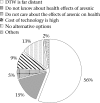Technical and social evaluation of arsenic mitigation in rural Bangladesh
- PMID: 19902804
- PMCID: PMC2928078
- DOI: 10.3329/jhpn.v27i5.3779
Technical and social evaluation of arsenic mitigation in rural Bangladesh
Abstract
Technical and social performances of an arsenic-removal technology--the sono arsenic filter--in rural areas of Bangladesh were investigated. Results of arsenic field-test showed that filtered water met the Bangladesh standard (< 50 microg/L) after two years of continuous use. A questionnaire was administrated among 198 sono arsenic filter-user and 230 non-user families. Seventy-two percent of filters (n = 198) were working at the time of the survey. Another 28% of the filters were abandoned due to breakage. The abandonment percentage (28%) was lower than other mitigation options currently implemented in Bangladesh. Households were reluctant to repair the broken filters on their own. High cost, problems with maintenance of filters, weak sludge-disposal guidance, and slow flow rate were the other demerits of the filter. These results indicate that the implementation approaches of the sono arsenic filter suffered from lack of ownership and long-term sustainability. Continuous use of arsenic-contaminated tubewells by the non-user households demonstrated the lack of alternative water supply in the survey area. Willingness of households to pay (about 30%) and preference of household filter (50%) suggest the need to develop a low-cost household arsenic filter. Development of community-based organization would be also necessary to implement a long-term, sustainable plan for household-based technology.
Figures







Similar articles
-
Value of arsenic-free drinking water to rural households in Bangladesh.J Environ Manage. 2005 Jan;74(2):173-85. doi: 10.1016/j.jenvman.2004.07.011. J Environ Manage. 2005. PMID: 15627470
-
Enhancing arsenic mitigation in Bangladesh: findings from institutional, psychological, and technical investigations.Sci Total Environ. 2014 Aug 1;488-489:477-83. doi: 10.1016/j.scitotenv.2013.11.143. Epub 2013 Dec 28. Sci Total Environ. 2014. PMID: 24377677
-
Rural communities' preferences for arsenic mitigation options in Bangladesh.J Water Health. 2006 Dec;4(4):463-77. J Water Health. 2006. PMID: 17176817
-
Arsenic contaminated groundwater and its treatment options in Bangladesh.Int J Environ Res Public Health. 2012 Dec 20;10(1):18-46. doi: 10.3390/ijerph10010018. Int J Environ Res Public Health. 2012. PMID: 23343979 Free PMC article. Review.
-
Case reports: arsenic pollution in Thailand, Bangladesh, and Hungary.Rev Environ Contam Toxicol. 2008;197:163-87. doi: 10.1007/978-0-387-79284-2_6. Rev Environ Contam Toxicol. 2008. PMID: 18983000 Review.
Cited by
-
Efficiency of Silver Impregnated Porous Pot (SIPP) filters for production of clean potable water.Int J Environ Res Public Health. 2012 Aug 24;9(9):3014-29. doi: 10.3390/ijerph9093014. Int J Environ Res Public Health. 2012. PMID: 23202668 Free PMC article.
-
Bangladesh arsenic mitigation programs: lessons from the past.Emerg Health Threats J. 2012;5. doi: 10.3402/ehtj.v5i0.7269. Epub 2012 Apr 30. Emerg Health Threats J. 2012. PMID: 22558005 Free PMC article.
-
Arsenic and Blood Pressure: A Long-Term Relationship.Environ Health Perspect. 2015 Aug;123(8):A218. doi: 10.1289/ehp.123-A218. Environ Health Perspect. 2015. PMID: 26230611 Free PMC article. No abstract available.
-
Parasitic Light Absorption, Rate Laws and Heterojunctions in the Photocatalytic Oxidation of Arsenic(III) Using Composite TiO2 /Fe2 O3.Chemistry. 2022 Mar 16;28(16):e202104181. doi: 10.1002/chem.202104181. Epub 2022 Feb 24. Chemistry. 2022. PMID: 35114042 Free PMC article.
-
LCA of Disposal Practices for Arsenic-Bearing Iron Oxides Reveals the Need for Advanced Arsenic Recovery.Environ Sci Technol. 2022 Oct 4;56(19):14109-14119. doi: 10.1021/acs.est.2c05417. Epub 2022 Sep 20. Environ Sci Technol. 2022. PMID: 36126259 Free PMC article.
References
-
- British Geological Survey. xvii. Dhaka: Department of Public Health Engineering; 2000. Arsenic contamination of groundwater in Bangladesh. V. 1–3. Main report.
-
- National Arsenic Mitigation Information Center. Dhaka: National Arsenic Mitigation Information Center; 2004. Upazila-wise summary of screening results; p. 2. ( http://www.bamwsp.org, accessed on 22 September 2008).
-
- Nickson R, McArthur J, Burgess W, Ahmed KM, Ravenscroft P, Rahman M. Arsenic poisoning of Bangladesh groundwater. Nature. 1998;395:338. - PubMed
-
- Yu WH, Harvey CM, Harvey CF. Arsenic groundwater in Bangladesh: a geostatistical and epidemiological framework for evaluating health effects and potential remedies. Water Resourc Res. 2003;39:1146–62.
Publication types
MeSH terms
Substances
LinkOut - more resources
Full Text Sources
Medical
Miscellaneous
